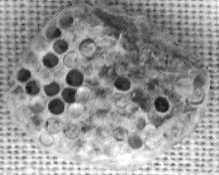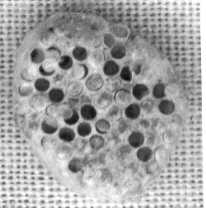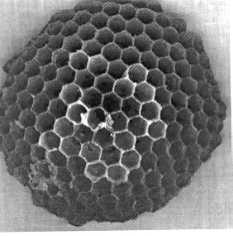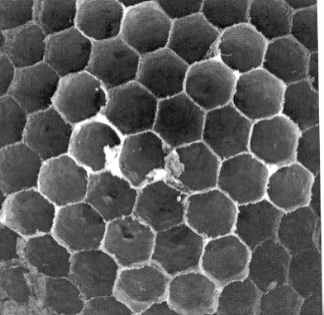Hymenopteran Cells
By John W Meiklejohn & Harry Green
Dolichovespula
There has been a national wasp survey this year so we have
been peering at wasp faces down a microscope to identify the
species (if you want to try wasp identification see excellent key
by George Else 1994). Practically every wasp we looked at was
Common wasp Vespula vulgaris and we have heard reports of
many nests in holes in the ground. Interestingly Geoff Trevis
found a wasps’ nest suspended in a bush and after it was
inactive he sent it off to national expert, Dr Mike Archer, who
confirmed that it was of the Median of French Wasp Dolichovespula
media. This European species was first recorded in Britain in
1980 with the first nest in 1985, both in Sussex. Since then it
has considerably extended its range with a few records in
Worcestershire (JM). This species has a bad reputation because
its big, supposedly French, and, allegedly, a vigorous attacker
of humans! This is probably because it suspends its nest in
bushes which people inadvertently cut, shake or bash, so
naturally the wasps try to see-off a possible predator! In the
early stages their paper nests have a typical tapering bottle-neck
-shaped entrance.
Coincidentally I was trimming a small laburnum tree in our
garden in September and noticed to my astonishment (we walk under
the tree every day!) a wasp’s nest suspended from a branch
about 10 ft up. The nest appeared to have failed as it was
inactive , and there were many unused cells - perhaps the queen
had died. It was about 14 cms diam and 17 cm high, and from its
shape I hoped it was D. media. I sent photos to Tom Ings (organiser
of the wasp survey) who wrote:
"I think you are right that it is a nest of D media,
it looks like the few I have seen. The early stages are much
easier to identify as they have a long narrow opening rather like
a bottle neck which disappears as the nest develops. As far as I
can tell from the photos the nest had not reached maturity and
produced new queens or males as there appears to be only small
cells and three combs. I can only assume that the queen died
before the nest was fully developed as there are no larvae etc,
then the workers must have carried on without the queen until all
had emerged".
In the hope of confirmation Geoff Trevis sent the photos to
hymenopterist Dr Michael Archer who confirmed that the nest was
of a species of Dolichovespula, and told us to measure the
width of the largest cells across the flats of the hexagon: D
media would measure 8 mm, other species 6-6.5mm. I had retained
the nest and the largest cells measured 6.1 mm!. However, as the
nest had not reached maturity, perhaps larger cells had not been
produced. On comparison with descriptions and pictures in
Spradbury (1973) I concluded that the nest was probably of
Norwegian Wasp D. norwegica, or possibly Tree Wasp D
sylvestris but might just maybe D media!
Braconid
I (GHG) visited the South Birmingham Group of Worcestershire
Wildlife Trust on 13th October 2000 to give a talk.. In the break
Malcolm Beach showed me a small branch of Lawson’s Cypress x
leylandii "Castle Welland" with several small masses of
tiny chambers about 1 cm diameter stuck to the twigs. He had
found them in a garden at Hawkesley, near Kings Heath, grid ref
about SP049773, in early October. Apart from a guess that they
might be made by a hymenopteran I did not know what they were so
I took some home and showed them to JWM. He did’nt know what
they were either so he sent one to Michael Chinery (of insect
Field Guide fame), who replied as follows:
"You are quite right about it being a clump of
hymenopteran cocoons or pupation chambers. It belongs to some
kind of braconid. I can't say which species, but Gauld &
Bolton (1988) mention Diolcogaster as one of the genera that
produce honeycomb-like stacks of cocoons. The parasites may well
have come from a small looper caterpillar - they often spin up
under the arched body of the victim and this gives the cluster
its neat shape. There is a very nice photograph of such a cluster
in Step's Bees, Wasps, Ants and Allied Insects - one of the old
Wayside and Woodland series.
The only looper that I know of that feeds on Lawson's cypress
is the Cypress Pug Eupithecia phoeniceata. This relative
newcomer to Britain is spreading northwards with the increasing
use of cypress hedges, although I don't know that it eats the
abominable leylandii. The caterpillars feed in the autunm and
winter, so this fits quite well if you have only recently found
the cocoons".
Skinner 1998 states that the first British specimen of Cypress
Pug was found in Cornwall in 1959 and has since spread through
the southern counties and has been recorded as far north as
Rugby, Warwickshire. The larvae will apparently eat Cupressocyparis
x leylandii in captivity! We had not yet checked current
status in Worcestershire and West Midlands.
Braconidae are small, active, inconspicuous insects, and the
great majority are parasitoids on other insects. They are
abundant worldwide and there are about 1045 species in 138 genera
in Britain (Gauld & Bolton 1996).
Acknowledgements
Many thanks to Geoff Trevis, Michael Archer Tom Ings and
Michael Chinery for helping us with our enquiries. Also to
Malcolm Beach for the Braconid cell cluster.
References



